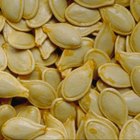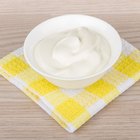Your body naturally produces malic acid when it converts the carbs you eat into energy. But malic acid is also naturally found in a number of fruits and vegetables, and it's added to processed foods as a preservative and flavoring. If you have fibromyalgia, your body has a difficult time making and using malic acid, and you may consider supplementation. But the evidence is very preliminary, says NYU Langone Medical Center, and supplementation may not be helpful. Knowing which foods are high in malic acid may help you up your intake without supplementation.
Naturally Rich Fruits
Fruits are a major source of malic acid, especially apples. In fact, malic acid is sometimes referred to as "apple acid," according to the Center for Science in the Public Interest. Ninety-four to 98 percent of the total acid in apples comes from malic acid, according to Bartek. Watermelon also contains a high amount of malic acid, which contributes 85 percent to 95 percent of its total acid content. Other fruit sources of malic acid include bananas, apricots, blackberries, cherries, lychees, peaches, pears and nectarines.
Malic Acid in Vegetables
Malic acid is also naturally present in a variety of vegetables. Good sources include broccoli, beans, carrots, peas, potatoes, tomatoes and rhubarb. It may be difficult to identify the malic acid taste in food as it adds a subtle and smooth sourness, says Bartek.
Foods With Added Malic Acid
As a food additive, malic acid is said to enhance overall flavor of the food it's used in. Malic acid may be found in hard and soft candy, gum, fruit preserves and baked goods with fruit fillings such as cookies and pies. It's also added to soy yogurt to give it a sour taste like traditional cow's milk yogurt.
Drinks With Added Malic Acid
Malic acid is also added to a variety of different drinks either as a flavor enhancer or preservative. You might find malic acid in your favorite carbonated or noncarbonated beverage, including regular and sugar-free. It's used in powdered iced tea and fruit-flavored drink mixes, as well as alcoholic ciders and wine. Malic acid may also be found in fruit-flavored dairy drinks to enhance the fruitiness of the drinks.
Related Articles

What Foods Provide Calcium D-Glucarate?

Alkaline & Acidic Foods & Drinks

The Shelf Life of Citric Acid

What Fruits Are Considered Aphrodisiacs?

Why Are Fruits Important?

Is Cranberry Juice Good for Acne?

What Is the Difference Between Roughage ...

How to Make a Fruit Reduction

What Are the Benefits of Grapefruit for ...

What Drink Can You Make With Vodka, ...

How to Make Liquid Sugar Concentrate

What Are the Ingredients in Yoplait ...

Does Cream of Tartar Contain Dairy?

What Makes Cream Liqueur Curdle in ...

Can You Make Sweet and Sour Without ...

What Is Certo Used For?

Different Types of Fruits & Vegetables

Information About the Orange Fruit

Grapefruit Skin Benefits

How to Make a Lip Mask for Extremely ...
References
Writer Bio
Jill Corleone is a registered dietitian and health coach who has been writing and sharing her love of food, nutrition and health with anyone who'll listen for almost 20 years. Her work has been featured on the Huffington Post, Diabetes Self-Management and Working Mother.